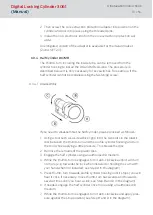
The locking cam is always in a pre-defined position in the AP cylinder when
disengaged. This prevents accidental blocking. Unlike other cylinder
versions, the AP cylinder is installed the other way round (inserted into the
lock from the inside to the outside).
6.3.2.1 Removing the inside thumb-turn
Loosen the inside thumb-turn's threaded pin (see diagram above) using an
Allen key. Do not unscrew completely. Hold the cam firmly and then turn
the inside thumb-turn anti-clockwise or, in the case of a freely rotating AP
cylinder, remove the thumb-turn after loosening the threaded pin.
6.3.2.2 Fastening the digital cylinder into the locking device
Turn the cam until it is vertical and pointing downwards. Insert the digital
locking cylinder through the locking device from the outside in such a way
that the outer thumb-turn is facing the outer side of the door. Fasten the
cylinder into the mortise lock with the fastening screw.
NOTE
You must not strike the thumb-turns when installing the cylinder. Do not al-
low the cylinder to come into contact with oil, paint or acids.
6.3.2.3 Fastening the inside thumb-turn
Screw the inside thumb-turn onto the thread until it locks into place as it
comes up against the cam. Pull on the inside thumb-turn, or push on the
inside thumb-turn of a freely rotating AP cylinder, until it locks into position.
Fasten the threaded pin tightly using the Allen key.
6.3.2.4 Functional test
To verify that the AP2 cylinder functions correctly in an anti-panic lock,
you must check that the cam moves easily and that the door opens
correctly using the procedure described below.
Carry out the functional test in the direction of escape.
You must carry out a functional test whenever the cylinder or the
fastening screw is repositioned.
You will need an authorised identification medium to carry out the
functional test.
Withdraw the dead bolt before the functional test.
Digital Locking Cylinder 3061
(Manual)
6. Installation instructions
28 / 54
















































